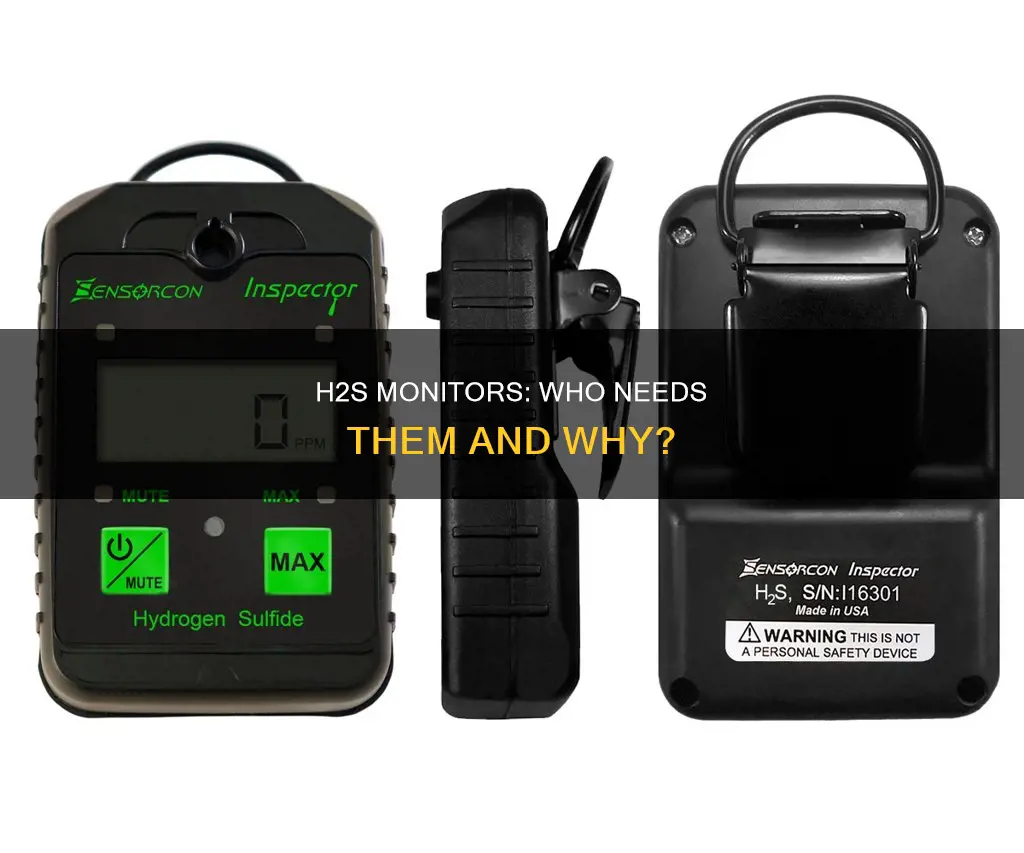
H2S monitors are essential safety devices that measure the concentration of toxic hydrogen sulfide (H2S) gas in the air and alert users to unsafe levels through audible, visual, and vibration alarms. These monitors are widely used in industries such as maritime, oil and gas, construction, mining, and wastewater management, where workers can be exposed to dangerous levels of H2S. Portable, clip-on H2S monitors are commonly used for personal protection, while stationary wall-mounted units are employed in industrial facilities or confined spaces with heavy occupational traffic. H2S monitors are available from various brands, including Forensics Detectors, Industrial Scientific, and Honeywell, with prices starting at less than $99. Online retailers like Amazon and Walmart offer a range of H2S monitors for customers to choose from.
| Characteristics | Values |
|---|---|
| Use | Detecting hydrogen sulfide (H2S) gas concentrations in the air |
| Users | People working in tanks, vessels, silos, pits, manholes, tunnels, well water, sewers, manure pits, oil and gas wells, volcanoes, utility holes, underground vaults, industrial settings, agricultural settings, natural environments, livestock operations, dairy farms, hog farms, geothermal areas, hot springs, volcanic regions, swamps, marshes, wetlands, sewers, septic tanks, textile manufacturing, pulp and paper processing, water and sewer industries, oil and gas industry, maritime, construction, mining, water, and wastewater |
| Features | Long-life battery, large screen, LED, vibration, and buzzer alarms |
| Price | Many models are available for less than $99 |
| Calibration | Calibration is the task of adjusting the detector to a more accurate reading; it is recommended to calibrate every 6-12 months |
| Bump testing | Exposing the detector to a small amount of gas to ensure it operates and alarms as programmed; should be performed daily, especially for personal protection |
| Sensors | Typically last from 24 to 36 months |
What You'll Learn

Maritime industry
The maritime industry is one of the several industries that require the use of H2S monitors. H2S, or hydrogen sulfide, is a toxic gas that is hazardous to human health even at low concentrations. It is a leading cause of workplace gas inhalation deaths in the United States, according to the Bureau of Labor Statistics (BLS). As such, it is imperative that workers in the maritime industry are protected from the dangers of H2S exposure.
H2S monitors are essential for ensuring the safety of maritime workers, especially those who work in confined spaces such as tanks, vessels, silos, pits, manholes, and tunnels, where H2S gas can accumulate to dangerous levels. The monitors detect the concentration of H2S gas in the air and alert workers through audible, visual, and vibration alarms when unsafe levels are present. This allows workers to take immediate action to avoid exposure and protect their health.
In the maritime industry, H2S monitors are typically used in environments where there is a significant risk of H2S exposure. This includes ships, ports, and other maritime locations where H2S gas may be present due to the nature of the work or the surrounding environment. For example, H2S monitors may be used on ships that transport oil and gas, as H2S is a by-product of the desulfurization process. Additionally, ports that handle a large volume of cargo, including organic matter and chemicals, may also require H2S monitors to protect workers from potential H2S exposure.
It is important for maritime companies to prioritize the health and safety of their workers by investing in H2S monitors and ensuring that workers are properly trained in their use. Regular calibration and maintenance of H2S monitors are also crucial to ensure their accuracy and reliability. By taking these precautions, the maritime industry can help protect its workers from the severe health risks associated with H2S exposure and create a safer work environment.
Connecting HP EliteBook to a Monitor: A Step-by-Step Guide
You may want to see also

Oil and gas industry
The oil and gas industry is one of the primary sectors that require H2S monitors to ensure the safety of workers. Hydrogen sulfide (H2S) is a highly flammable, explosive, and toxic gas that can pose a significant risk to human health. Oil and gas refineries, as well as drilling and servicing operations, can expose workers to this hazardous gas.
H2S monitors are essential for detecting the presence of H2S in the atmosphere and alerting workers when levels exceed certain thresholds. The Occupational Safety and Health Administration (OSHA) has set specific permissible exposure limits (PEL) for H2S, which H2S monitors are designed to detect. In the oil and gas industry, workers may encounter H2S during the desulfurization process or when dealing with oil and gas wells.
To ensure the safety of their employees, companies in the oil and gas sector should provide portable H2S monitors that can be easily worn by workers in their breathing zone, typically clipped to their clothing. This allows for continuous monitoring of H2S levels and immediate alerts in case of unsafe conditions.
H2S exposure can lead to a range of health issues, from eye irritation and headaches to unconsciousness and even death. Therefore, the use of H2S monitors is crucial in the oil and gas industry to prevent accidents and protect workers' health. Regular calibration and bump testing of these monitors are also necessary to ensure their accuracy and reliability.
LCD Monitors: Enhancing Your In-Car Experience
You may want to see also

Construction industry
The construction industry is one of the many industries that rely on H2S monitors to ensure the safety of their workers. Hydrogen sulfide (H2S) is a toxic gas and one of the leading causes of workplace gas inhalation deaths in the United States. As a result, the use of H2S monitors is crucial in environments where this hazardous gas may be present.
H2S monitors are essential for construction sites, especially when working in confined spaces such as tanks, vessels, silos, pits, manholes, and tunnels, where H2S gas can accumulate to dangerous levels. These monitors detect hydrogen sulfide gas concentrations and alert workers through audible, visual, and vibration alarms when unsafe levels are reached, allowing them to take immediate action to avoid exposure.
In the construction industry, H2S gas can be encountered in various situations. For example, when working with concrete, as it can be released from the concrete itself or when drilling through it. Additionally, H2S can be generated during the curing process of concrete, which can pose a risk to workers in the area.
Another scenario where construction workers may encounter H2S is during excavation. Disturbing the soil can release the gas, especially in areas with a high organic content or where sulfur-containing materials are present. This includes construction projects near swamps, marshes, or landfills, where the presence of H2S is more likely.
Furthermore, H2S monitors are crucial when construction activities involve breaking through or working near sewer lines. Sewers are a common source of H2S due to the decomposition of organic matter, and any damage to these lines can release the gas, posing a significant risk to workers and bystanders.
To summarize, H2S monitors are vital to the construction industry as they provide early warning of hazardous H2S levels, helping to protect workers from the severe health risks associated with hydrogen sulfide exposure. By using these monitors, construction companies can ensure a safer work environment and potentially save lives.
Capturing LCD Monitors: Tips for Perfect Pictures
You may want to see also

Mining industry
The mining industry is one of the many industries that rely on H2S monitors to protect workers' health and safety. Hydrogen sulfide (H2S) is a toxic, colorless gas with a potent rotten smell, and it is generated in a variety of industries, including mining. Exposure to H2S is extremely dangerous and can cause eye irritation, headaches, unconsciousness, and even death. Therefore, it is crucial for workers in the mining industry to use H2S monitors to detect the presence of this hazardous gas and ensure their safety.
H2S monitors are essential for miners working in confined spaces, such as tanks, vessels, silos, pits, manholes, and tunnels, where H2S gas can accumulate to dangerous levels. By wearing portable H2S monitors in their breathing zone, miners can be alerted when H2S levels reach unsafe concentrations. These monitors provide real-time detection of H2S gas and warn workers through audible, visual, and vibration alarms, allowing them to take immediate action to avoid exposure.
The use of H2S monitors is particularly important in the mining industry due to the potential presence of hazardous gases. Miners often work in enclosed areas where H2S gas can build up, posing a significant risk to their health and safety. H2S monitors help miners identify unsafe air quality and take the necessary precautions, such as evacuating the area, improving ventilation, or wearing protective gear.
In addition to personal protection, H2S monitors can also be used for stationary fixed wall detection in mining shafts. These wall-mounted units provide continuous protection and are more expensive than portable monitors. They are designed to withstand harsh mining environments and offer reliable H2S detection over a long period.
To ensure accurate readings, it is crucial for miners to properly maintain their H2S monitors. This includes regular bump testing, which involves exposing the monitor to a known concentration of H2S gas to ensure it is functioning properly. Calibration is also essential to adjust the detector for more accurate readings over time. By following these maintenance procedures, miners can trust that their H2S monitors will provide reliable warnings when H2S levels become unsafe.
LCD Monitor Options: What to Consider When Buying
You may want to see also

Water and wastewater industry
The water and wastewater industry is one of the key sectors that utilise H2S monitors. Hydrogen sulfide (H2S) is a highly toxic gas that poses a significant risk to workers in this industry. The gas is generated during the decomposition of organic matter and can be found in sewage, manure pits, and other wastewater environments.
H2S monitors are essential safety devices that help protect workers from the dangers of H2S exposure. In the water and wastewater industry, H2S monitors are used in various applications, including:
- Sewer systems: H2S can accumulate in sewer networks, creating a hazardous environment for workers. H2S monitors are used to detect unsafe levels of the gas and alert workers to potential dangers.
- Wastewater treatment plants: Wastewater treatment facilities often deal with high levels of organic waste, which can produce H2S. H2S monitors are used to ensure the safety of workers and help manage odour and corrosion control.
- Manholes and confined spaces: Workers entering manholes or confined spaces, such as sewer pipes and septic tanks, are at risk of H2S exposure. H2S monitors are essential to ensure the safety of these workers by detecting H2S levels and providing early warnings.
- Agricultural wastewater: In agricultural settings, such as livestock operations, H2S can be generated during the decomposition of manure. H2S monitors are used to protect workers from exposure to toxic gas levels.
H2S monitors for the water and wastewater industry come in various forms, including portable, clip-on, and wall-mounted devices. These monitors typically use electrochemical sensors to detect H2S levels and provide alerts through audible, visual, and vibration alarms. Regular calibration and bump testing of these devices are crucial to ensure their accuracy and reliability.
Monitor Refresh Rates: Understanding MHz in Modern Displays
You may want to see also







